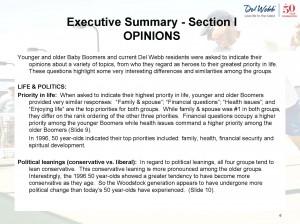The Need for Marketing Strategy for Mid-Sized Organizations
We live in a faced-paced world with incredible changes every day. While there has always been change, never before has so much changed so quickly. Entire industries are being rendered obsolete as others (which no one had even thought of two years ago) are being valued at billions of dollars. Opportunties are endless. Resources are not.
More than ever, managers today must try to anticipate the future and prepare their companies to thrive in it. This is what Marketing Strategy is about.
Many people think strategy is just for large, global companies like Microsoft or GE. These companies make strategy a priority, and then they devote tremendous amount of resources to the effort. Weeklong retreats, bringing in outside consultants, devoting still more time and money to aligning the entire organization with the strategy
You may be asking, “What do these examples have to do with my medium size or smaller organization?”
It’s perhaps even more critical for small and medium sized businesses to devote resources to developing appropriate strategies, or their owners will lose everything for which they have worked so hard. You don’t have a lot of time and money to invest; you need to make sure every dollar is spent on the right vehicles reaching the right targets at the right time with the right message.
You may not be Fortune 500, but I’d say you’re the “fortunate 5000.” There are three steps you can take today to ensure the good fortunes of your organization.
1. Fully utilize all of your assets.
What resources and capabilities can you leverage to meet customer needs better than competitors?
Slenker Communities, a MidAtlantic developer had a strong brand, known for fun-filled 55+ lifestyle communities in desirable locations. These Central Parke communities also featured exceptional and large clubhouses. The organization recognized that this physical space was an impressive but under utilized resource that could help them meet homeowner desires for more learning opportunities.
 Slenker entered into a special partnership with the University of Maryland that established an OLLI (Osher Lifelong Learning Institute) “campus” right at its Laurel, MD community. Central Parke leveraged the clubhouse it had already paid for to host classes conducted by University of Maryland faculty. (Two of these professors later moved to the community.)
Slenker entered into a special partnership with the University of Maryland that established an OLLI (Osher Lifelong Learning Institute) “campus” right at its Laurel, MD community. Central Parke leveraged the clubhouse it had already paid for to host classes conducted by University of Maryland faculty. (Two of these professors later moved to the community.)
The partnership allowed the brand to enhance the lifestyle enjoyed by residents and to extend brand awareness. Each class was open to ALL older adults in the area, not just Central Parke residents. Classes brought new prospects onto the campus, showing (not telling) how Slenker could meet their ongoing needs. Though the program is no longer active — and it required two years of planning to make it happen –, it is a great example of adding tremendous value without adding much cost.
2. Anticipate the future.
How will customer needs change? How will competition change? Will there be substitutes to my products and services? What do I need to do TODAY to increase the odds of the company surviving and prospering in the future?
 How to: Don’t wait until there’s a drop in sales before you begin to actively ask questions. Large or small, companies that lead are constantly researching. Del Webb, a builder of active adult communities, surveys both its current residents and those they hope will purchase in the future. Many of the questions relate not to square footage or kitchen features, but to the baby boomer mindset. The results are not just a great PR opp for Del Webb, they influence where and how the builder spends its time.
How to: Don’t wait until there’s a drop in sales before you begin to actively ask questions. Large or small, companies that lead are constantly researching. Del Webb, a builder of active adult communities, surveys both its current residents and those they hope will purchase in the future. Many of the questions relate not to square footage or kitchen features, but to the baby boomer mindset. The results are not just a great PR opp for Del Webb, they influence where and how the builder spends its time.
On a smaller scale, Traditions of America is always taking the pulse of customers. They employ a range of listening tools including lost customer surveys, direct conversations with depositors/new residents, mailed surveys and online polling. Feedback from 50+ homebuyers has influencedthe choice of amenities for new communities.
This builder also stays on top of national trends. For example, a rise in the number of single women over 50 prompted Traditions to take a closer look at the needs of this “niche.” Feedback from older women then led to an overhaul of a floor plan, “The Abigail.” It went on to become one of their fastest sellers at Traditions of America at Liberty Hill, their State College, PA community.
 3. Align stakeholders with the Strategy.
3. Align stakeholders with the Strategy.
Get employees, suppliers, customers, and processes in sync.
Small to medium sized organizations typically don’t have the financial resources for Super Bowl ads or “carpet-bomb” campaigns that dominate local media. So their messages must be delivered strategically. And those strategic messages must be understood and “lived” by stakeholders.North Hill, in Needham, MA was entering into a major transformation of its physical campus and an evolution of the opportunities offered at the retirement community. They started not with a new logo but with a deep look within.
Surveys and workgroups of team members explored values at the core of the North Hill experience. Trustees and residents were educated on the steps being taken and on new initiatives that flowed from research: everything from marketing designs to a commitment to universal language. Team member development was made a priority. Select employees became “Brand Champions,” not just communicating marketing efforts but sparking new, innovative ideas for services and programs.This synchronized approach has paid off in resident and team member satisfaction, increased efficiencies and a more powerful marketing program that has generated leads, boosted occupancy and been nationally recognized for it innovative approach and execution.
Think you’ve got to be Fortune 500 to succeed? Think again.These businesses have proven that good fortune comes from forgetting size and remembering to invest on marketing strategy.
Marketing strategy many not have the immediate gratification of a new campaign or the excitement of trying the trending marketing tatics, but it’s the single-most important step your organization can take to reduce costs and build lasting value.



